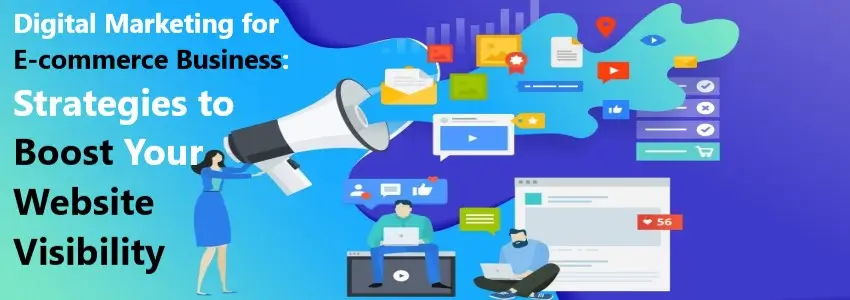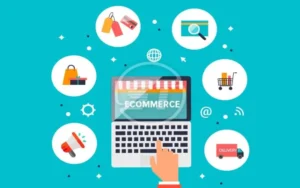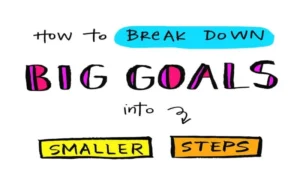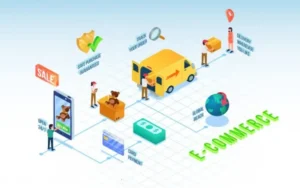
In the dynamic and highly competitive world of e-commerce, visibility is vital to success. No matter how great your products are, your sales will suffer. Potential customers need help finding your websites are good. Digital marketing offers many strategies to enhance your online presence, attract traffic, and convert visitors into loyal customers. This blog, “Digital Marketing for E-commerce Business,” will explore digital marketing techniques tailored explicitly for e-commerce businesses, providing actionable insights to boost your website visibility and drive growth.
Digital Marketing for E-commerce Business
“Just like advertising is part of marketing, eCommerce advertising is part of e-commerce marketing. Using them together can better reach your audience members, increase sales, and raise brand awareness.” As I said in the description, e-commerce marketing is about getting people to know about and buy your goods or services. E-commerce advertising, on the other hand, covers the ways you market your goods.
 Display ads, banner ads, and rich media ads are some of the different ads that can be used to make and sell things online. The main thing you should take away from this is that e-commerce advertising is an excellent way to promote your product or service while working on your e-commerce marketing plan. Let’s go back to our in-depth talk about digital marketing for e-Commerce businesses.
Display ads, banner ads, and rich media ads are some of the different ads that can be used to make and sell things online. The main thing you should take away from this is that e-commerce advertising is an excellent way to promote your product or service while working on your e-commerce marketing plan. Let’s go back to our in-depth talk about digital marketing for e-Commerce businesses.
The Importance of Digital Marketing for E-commerce Business
Digital marketing for e-commerce businesses is essential for several reasons:
- Reach: It allows you to reach a global audience.
- Cost-Effective: Digital marketing is often more affordable than traditional marketing methods.
- Measurable: It provides quantifiable results, allowing you to track your return on investment (ROI).
- Engagement: It enables direct interaction with customers, fostering loyalty and trust.
Platforms Digital Marketing Strategies for E-commerce Business
Search Engine Optimization (SEO)
Keyword Research:
The foundation of any successful SEO strategy is thorough keyword research. Identify keywords that your potential customers are searching for. Tools like Google Keyword Planner, Ahrefs, and SEMrush can help you find relevant keywords with high search volume and low competition.
On-Page SEO:
On-page SEO involves optimizing individual pages on your website to rank higher in search engine results. Focus on the following elements:
- Title Tags: Create compelling title tags that include your target keywords.
- Meta Descriptions: Write informative meta descriptions that entice users to click on your links.
- Header Tags: Use H1, H2, and H3 tags to structure your content and make it more readable.
- Alt Text for Images: Add descriptive alt text to your images to improve accessibility and SEO.
Content Creation:
Content is king in the world of SEO. Regularly publish high-quality, relevant content that addresses the needs and interests of your target audience. Consider starting a blog to share valuable insights, product guides, and industry news. This will help with SEO and position your brand as an authority in your niche.
Social Media Marketing
Platform Selection:
Only some social media marketing platforms are equally effective for some businesses. Choose platforms where your target audience is most active. Due to their visual nature, Instagram, Facebook, and Pinterest are often effective for e-commerce businesses.
Content Strategy:
Develop a content strategy that resonates with your audience. Share a mix of product images, user-generated content, behind-the-scenes glimpses, and engaging stories. Use hashtags strategically to increase your reach.
Influencer Collaborations:
Partnering with influencers can significantly boost your brand’s visibility. Choose influencers whose audience aligns with your target market. Micro-influencers, in particular, can offer high engagement rates at a lower cost.
Email Marketing
Building Your List:
Your email list is a valuable asset. Encourage website visitors to subscribe to your newsletter by offering incentives such as discounts, exclusive content, or free resources.
Personalization:
Personalized emails are more likely to be opened and acted upon. Use segmentation to send tailored content to different segments of your audience based on their preferences and behaviors.
Automated Campaigns:
Set up automated email campaigns for customer journeys, such as welcome series, abandoned cart reminders, and post-purchase follow-ups. Automation ensures timely and relevant communication with your customers.
Advanced Digital Marketing Strategies
You now know everything about e-commerce marketing. Let’s combine this knowledge and review some tips for creating a good marketing plan for your online store.
Set goals based on standards in your field:
 There are standards you can use to measure your goals that depend on your area, business size, industry, and many other things. These standards are called industry benchmarks. Compare your goals to those of other e-commerce businesses in the same field. Some examples are website hits, click-through rates, conversion rates, and the cost of getting a new customer.
There are standards you can use to measure your goals that depend on your area, business size, industry, and many other things. These standards are called industry benchmarks. Compare your goals to those of other e-commerce businesses in the same field. Some examples are website hits, click-through rates, conversion rates, and the cost of getting a new customer.
Break Your Plan Down Into Small Steps:
You can make a marketing plan for your online store in many ways, many of which we’ve already told you about. While it might be tempting to go after all of them, that will not help you with any of them. Focus on a few key strategies that will give you the best return on investment (ROI) and are most straightforward to implement. Then, make action plans for each of them. For instance, you focused on a paid approach to get people to visit your shop.
 You should start a Google Ads account, figure out how much you want to spend on ads, create an ad group based on your goal keywords, and check your account daily. It may sound too simple, but that’s because it should be. You don’t want to waste time looking for the next “great e-commerce strategy” instead of implementing one and letting it work for you.
You should start a Google Ads account, figure out how much you want to spend on ads, create an ad group based on your goal keywords, and check your account daily. It may sound too simple, but that’s because it should be. You don’t want to waste time looking for the next “great e-commerce strategy” instead of implementing one and letting it work for you.
Make Your New and Old Customers Happy:
Marketing doesn’t end when a sale is made. When someone buys from you, you should keep in touch, care for them, and make them happy. This will help your customers succeed in the long run and make them more loyal. It will also make your customers want to tell your leads and target audience members about their excellent experiences through case studies, reviews, recommendations, and word of mouth.
Get Ready to Sell:
E-commerce businesses can use many marketing tools. Using digital and social marketing correctly can help your online store reach more people and grow.
Pay-Per-Click (PPC) Advertising
Google Ads:
Google Ads is a powerful tool for driving targeted traffic to your website. Create campaigns that target relevant keywords and use ad extensions to enhance your visibility.
Social Media Ads:
Platforms like Facebook, Instagram, and LinkedIn offer robust advertising options. Utilize their targeting features to reach specific demographics, interests, and behaviors.
Retargeting:
Retargeting ads are displayed to users who have previously visited your website. This strategy keeps your brand top-of-mind and encourages return visits and conversions.
Content Marketing
Blogging:
A well-maintained blog can drive organic traffic, build brand authority, and engage your audience. Write about topics relevant to your industry and address common pain points of your customers.
Video Marketing:
Videos are highly engaging and shareable. Create product demonstrations, tutorials, and customer testimonials to showcase your offerings and build trust with potential customers.
Infographics:
Infographics are visually appealing and easy to digest. Use them to present complex information engagingly and encourage social sharing to increase your reach.
Leveraging Analytics and Data
Google Analytics:
Google Analytics is an invaluable tool for tracking your website’s performance. Monitor key metrics such as traffic sources, bounce, and conversion rates to understand how users interact with your site.
Customer Data:
Analyze customer data to gain insights into their behavior and preferences. Use this information to refine your marketing strategies and create more personalized experiences.
A/B Testing:
A/B testing involves comparing two versions of a webpage or ad to determine which performs better. Continuously test and optimize elements such as headlines, images, and CTAs to improve your conversion rates.
Enhancing User Experience (UX)
Mobile Optimization:
With the increasing use of mobile devices, ensuring your website is mobile-friendly is crucial. Optimize your site’s design and performance for mobile users to reduce bounce rates and improve conversions.
Page Speed:
Page speed is critical for user experience and SEO. Use tools like Google PageSpeed Insights to identify and fix issues slowing down your site.
Clear Call-to-Actions (CTAs):
Ensure your CTAs are clear, compelling, and strategically placed throughout your website. These should guide users towards desired actions, such as purchasing or signing up for your newsletter.
Building Trust and Credibility to Get Your Target Audience
Customer Reviews and Testimonials
Encourage satisfied customers to leave reviews on your website and third-party platforms like Google My Business and Yelp. Positive reviews build trust and credibility.
Secure and Easy Checkout
A secure and easy checkout process is essential for reducing cart abandonment rates. Offer multiple payment options and ensure your site uses SSL encryption to protect customer data.
Transparent Policies
Communicate your return, shipping, and privacy policies. Transparency fosters trust and reassures customers that they can shop with confidence.
Encouraging User Content
Encourage your customers to share their experiences with your products on social media. Create branded hashtags and run contests or giveaways to incentivize participation.
Showcasing User Content
Feature user-generated content on your website and social media channels. This will provide social proof and foster community and loyalty among your customers.
Why Does Digital Marketing Matter for E-commerce Business?
Many people believe that the best way to do well in e-commerce is to have great, one-of-a-kind items. They’ll say, “Once you build it, they will come.” I’m sorry to disappoint you. That couldn’t be further from the truth.
 Even though having a good product is essential, people will only buy it if they know about it. This is why marketing is critical. No one but you know what you’re doing when you wink at someone in the dark. With e-commerce, you sell things online, so it makes sense to market your business online, too. People who are already online are more likely to buy from you.
Even though having a good product is essential, people will only buy it if they know about it. This is why marketing is critical. No one but you know what you’re doing when you wink at someone in the dark. With e-commerce, you sell things online, so it makes sense to market your business online, too. People who are already online are more likely to buy from you.
With so many more people using the internet, reaching millions worldwide who are like your ideal buyer is easy. In other words, digital marketing lets you contact more people and ensures that your ads are seen by the right people (a pre-defined target), which lowers your marketing costs.
What’s more, recent developments in digital marketing have used technologies like AI and machine learning. This means you can give each customer a unique experience throughout the buying process. Contact me for more information!
